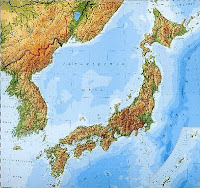 Many Christians know about church history in the days of the apostles and the Reformation Movement in the days of Martin Luther and John Calvin. Few however know the history of Christianity in Asia, how it began and how it has expanded to what it is today.
Many Christians know about church history in the days of the apostles and the Reformation Movement in the days of Martin Luther and John Calvin. Few however know the history of Christianity in Asia, how it began and how it has expanded to what it is today.This article details how Christianity began in Japan and Korea.
JAPAN
The earliest record of Christianity in Japan dates back to the sixth century. In those days, the people of Japan were already making contact with China, during which time Christianity was embraced by the Tang emperor. Japanese visitors to China in both the Tang (618-906) and Yuan (1260-1368) dynasties were believed to be influenced by Christian teachings while they were there and some missionaries were also believed to have visited Japan.
Francis Xavier, a Jesuit, brought in Christianity to Japan in 1549. His work was continued by both his and other Catholic Orders such as the Franciscans and Dominicans, which brought about 250 churches by 1582. Protestant missionary work in Japan began in 1859 with highly gifted men in various fields who were known for their spiritual depth. These men included James C Hepburn of the Presbyterian, Channing M Williams of the Episcopal, and Samuel R Brown of the Reformed.
At first, the government authorities permitted missionary effort only because they did not want to offend the treaty powers. In 1873, when the Japanese government learnt that religious freedom was a prerequisite to revision of the unequal treaties, a new surge in evangelization spread through Japan.
Today, about one to two million Japanese are Christians, constituting to about only 1% of Japan's population. Most of them live in Western Japan where missionaries' activities were greatest during the sixteenth century.
KOREA
No record of missionaries or organized body of believers in Korea was found before the middle of the seventeenth century, although there were traces of Koreans having contact with Christianity as far back as 1592, many of whom were converted Christian members of the invading Japanese armies of Toyotomi Hideyoshi.
In 1784, a young man, Yi Seung-hun, at the requests of some Korean scholars, went to Beijing in search of missionaries to ask them about the strange Catholic doctrines which had been filtering across the border since 1631 through smuggled Christian literatures. On returning to Korea after a few months, he began to spread the faith. By the time the first priest and foreign missionary Chou Wen-Mo arrived ten years later, there were already 4,000 Catholics in Korea.
During the years 1810, 1839, 1846 and 1866, great persecutions took place and many suffered martyrdom. Christianity however could not be stamped out, and many were driven underground and scattered.
In 1832, a Protestant German Carl Gutzlaff distributed Scriptures along the eastern coast of Korea, and in 1866, a Welshman Robert J Thomas lost his life in a similar attempt. He was killed at P'yongyang in the act of offering a Bible to the man who beheaded him, and he is revered as Korea's first Protestant martyr. Two Scots, John Ross and John MacIntyre baptized the first Korean Protestant in Manchuria in 1876, and it was one of the Koreans baptized in Manchuria who established the first worshipping Korean Protestant congregation after winning over a 100 believers to Christ when he returned to Korea in 1883.
Beginning 1895 and continuing about 15 years, there was dramatic explosion in the growth of the Protestant church in Korea. This was spearheaded by the evangelistic work of Samuel A Moffett and his colleagues in the Presbyterian churches northwest of Korea. Christianity was later spread nationally in the Great Revival of 1907. Denominational barriers were broken, and Christians were moved to join together in witness, and in those 15 years, the Protestant community grew from 802 in 1895 to 167,352 in 1910.
During World War II, North Korea was held by the Communists who immediately destroyed the church as an organized body. By 1950, when the Communists attacked South Korea, the church in North had almost ceased to exist. When the United Nation's armies advanced to the Yalu River, 4.5 million North Koreans fled south to freedom.
The exact number of Christians in North Korea today is unknown, and the number of Christians in South Korea appears to vary vastly from different sources of information. According to CIA's World Factbook, Christians and Buddhists comprise 26% of the population of South Korea today, but other sources claim about 49% of the population are Christians.
BIBLIOGRAPHY
- Hoke, Donald. The Church in Asia. Chicago, IL: Moody Press, 1975.
- Japan Guide. Christianity. Accessed 3 Mar 2009.
- Kim, Andrew. A History of Christianity in Korea. Accessed on 3 Mar 2009.
- Law, Gail. Chinese Churches Handbook. Hong Kong: Chinese Coordination Centre of World Evangelism, 1982.
- Ng, Edmond. Church History in Asia (2005). Accessed 3 Mar 2009.
- Wikipedia. Christianity in Japan. Accessed 3 Mar 2009.
- Wikipedia. Christianity in Korea. Accessed 3 Mar 2009.
No comments:
Post a Comment